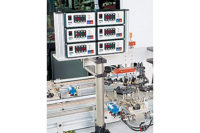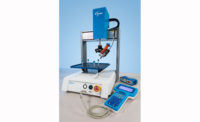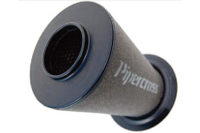Designed for high-volume manufacturing, precision, thin-wall conical nozzles boost the capability of automated dispensing equipment. Thin-wall nozzles improve placement precision, deposit accuracy and flow-rate repeatability.
Thin-wall nozzles are manufactured using the deep drawing process. Deep drawing forces a malleable metallic disk into a series of cavities in progression, using punches to draw down a formed section so metal can be pulled into the shape of the next cavity in the series. Each cavity differs in size and shape. As the nozzle progresses from one cavity to the next, the metal is incrementally work-hardened until the desired shape is formed. Wall thickness can be selectively varied in each step.
Making a thin-walled, monolithic nozzle is only possible with the right material. Copper alloys exhibit an innate propensity to work-harden at a rate that is substantially less than stainless steel. Two copper alloys that are well-suited to this process are nickel-silver and phosphor-bronze. With these alloys, more progressions can be used to draw the metal down to produce finer detail with a thinner wall and optimized geometry for fluid transmission. They are also more rigid and can handle higher pressures without compliance.
The surface finish of these metals must be smooth, dimensionally accurate and highly polished prior to entering the first progression in the deep-drawing process. As a result, the thin walls of the nozzle will retain that finish, because the metal is stretched instead of cut.
Nozzles vs. Cannulas
Conventional needles for robotic dispensing systems are made from medical-gauge tubing and sized according to their outside diameter. However, automated dispensing of adhesives and other fluids on the assembly line is different from drawing blood or administering an injection. Medical needles require high column strength to resist failure from buckling, since they are heavily loaded in compression. High compressive loads are required to pierce the skin to administer an injection of a low-viscosity fluid.
Robotic dispensing of higher viscosity fluids does not exert large, axial compressive loads on the nozzle. Forces are applied differently. Gravity, pressure and small tensile forces are the most common loads. A thin, rigid wall produced by cold working the material can resist high pressure without substantial deflection of the nozzle wall, which could adversely affect the volume dispensed.
Variability in fluid deposits can be caused by deflection of the tube wall or other components in the fluid path. After fluid flow is terminated and pressure is relieved, relaxation of these components can produce unwanted deposits on the workpiece.
The surface finish of the nozzle can also make a big difference. A smooth surface finish inside the nozzle decreases the thickness of the boundary layer at the fluid-wall interface, alleviating obstructions and reducing the propensity of filled fluids to clog. A rough interior surface increases the width of the boundary layer at the fluid-wall interface, impeding flow and encouraging build-up of particles in filled fluids.
This is an important consideration in difficult applications that require precise exit apertures and minimal facial-area exposure. Minimizing facial-area exposure reduces the fluid’s ability to cling and allows cleaner break off of the fluid stream. Thin vertical walls around the circumference of the exit aperture, coupled with a reduction in run-out tolerance made possible by monolithic construction, also means the nozzle can get closer to the target during dispensing.
Monolithic construction provides a more contiguous flow channel and blocks exposure to ambient ultraviolet light, which can cause problems with curing of adhesives in the nozzle. Vertical walls make it difficult for fluids to climb up the side of the nozzle. Gravity inhibits adhesives from wicking up the exterior wall and keeps the fluid at the exit aperture.
Some manufacturers employ exterior chamfers to thin the cross section around the outside diameter of the exit aperture to aid fluid break off. However, this practice dilutes the influence of gravity and aids fluid migration.
Nozzle cores can be coated or uncoated. Nickel-silver nozzles are typically uncoated and are used to dispense adhesives. However, coatings can be applied to either nickel-silver or phosphor-bronze nozzles to improve their performance. Either alloy can be coated with electroless nickel or Entecoat. Both coatings are hard and resist abrasion.
Developed by Symcoat, Entecoat is a nickel alloy composite with a matrix of nickel and polytetrafluoroethylene (PTFE). This nonstick coating has hydrophobic properties that help prevent wicking. It can be applied accurately and uniformly on all surfaces of the nozzle core. Entecoat exhibits the greatest beneficial effect when used with aqueous-based fluids. A phosphor bronze nozzle treated with Entecoat is preferred for biomedical applications.
Nozzle geometry should be selected to minimize pressure at a selected flow rate and diminish the volume of fluid retained ahead of the Luer taper. Too much fluid ahead of the taper exacerbates any propensity of the system to drip. Directing the dispensing system to “suck back” some of this excess fluid can mitigate the problem. However, too much fluid ahead of the taper also inhibits the response time of the dispensing system, which can lead to problems with fast-curing materials.
A conical nozzle will greatly reduce fluid pressure requirements. Compared with a cannula, pressure is reduced by approximately three times at an equivalent flow rate. Put another way, the flow rate will increase by three times at an equivalent pressure. The conical shape is rigid, which results in a high propensity to resist bending compared with needles made from straight tubular cross sections.
Thin-wall nozzles are connected to the fluid delivery system through a hub with twin-helix Acme threads that mate with the Luer connection. The hub locks the nozzle core to the Luer taper to prevent separation from the taper under pressure. A hub can be made separable or attached permanently to the nozzle core.
Molded color-coded polypropylene hubs are permanently attached. Reusable hubs are separable. The latter reduce waste, since only the wetted core is thrown away. The hub, which is machined from stainless steel or tellurium copper, is reused.
At the end of the nozzle is a short straight section, approximately 1 millimeter long, that enables the nozzle to access confined areas. The outside diameter of this straight section is based on standard medical-gauge tubing sizes. However, nozzles designed specifically for robotic dispensing have considerably thinner walls, so they can be produced with a larger inside diameter for a given gauge size. Thus, it’s possible to make a nozzle with an exit aperture as small as 50 microns and rigid walls of 0.05 millimeter or less.
For more information on nozzles for automated dispensing, call Subrex at 760-436-1521, e-mail info@subrex.com, or visit www.subrex.com.







